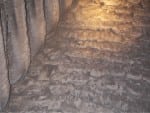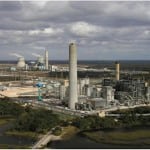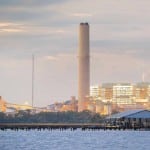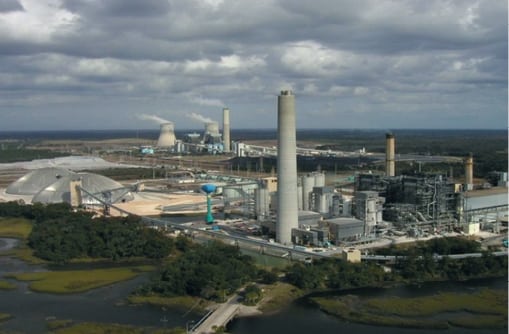 |
![]()
Since the Northside Generating Station’s two repowered units were placed into service in 2002, a series of modifications and repairs have been undertaken to make its two circulating fluidized bed boiler plants reliable. The two chief problems were ash agglomeration on heat transfer surfaces and poor Intrex heat exchanger performance. JEA reports these problems have been permanently resolved, and data shows the two units have joined the top tier of reliable fossil plants.
The original Northside Generating Station (NGS) consisted of three oil/gas-fired thermal plants: Units 1 and 2 were 275-MW designs; Unit 3 was 618 MW. Unit 1 began service in 1966, Unit 2 was built in 1972 but was idled in 1983, and Unit 3 was completed in 1977. The need for additional baseload generation prompted a 1997 study that concluded Units 1 and 2 were good candidates for repowering: removing the old boilers and replacing them with new ones. Negotiations with Foster Wheeler and the U.S. Department of Energy (DOE) produced a contract under the DOE’s Clean Coal Technology Program for the construction of two circulating fluidized bed (CFB) boilers nominally rated at 300 MW each. Unit 3 continues to operate today, principally on natural gas with oil backup.
The official project title was the JEA Large-Scale CFB Demonstration Project. The DOE cost-shared about 25% in the first unit (Unit 2), and JEA paid the remaining cost of Unit 2 and the total cost of Unit 1. At the time of construction, the two CFBs were among the world’s largest. Foster Wheeler supplied the extended boiler island scope, which included the CFB boilers and air quality control system, as well as engineering, procurement, and construction management services. Black & Veatch provided supplemental engineering services to JEA.
Construction began on the two units in July 1999. Initial synchronization of Unit 2 occurred on Feb. 19, 2002, followed by Unit 1 on May 29, 2002. As part of the cooperative agreement, the DOE cost-shared two years of demonstration test runs, during which both coal and coal/petroleum coke (petcoke) blends were to be fired. Other specific details of the project design can be found in the final technical report issued in June 2005.
In 2002, POWER named NGS its Plant of the Year Award (then called the Powerplant Award) winner. In the September 2002 issue, the editors noted the justification for the award: “The development of a successful repowering strategy for converting existing oil/gas-fired steam plants to solid fuels to increase efficiency while reducing both emissions and the cost of electricity.”
Operational Realities
JEA CFB boilers were designed to burn 100% coal or 100% petcoke or a mixture of both. The desired fuel at the time of commissioning was 100% petcoke, as it was the lowest cost fuel. JEA successfully burned petcoke/coal blends in both units, although higher ratios of petcoke and 100% petcoke quickly produced agglomeration of ash in the integrated recycle heat exchanger (Intrex) and furnace heat transfer surfaces within weeks. Unable to maintain steam temperatures, the plant was forced to shut down to remove the excessive ash buildup. Further testing found that a maximum blend of 70% petcoke produced minimally acceptable plant reliability.
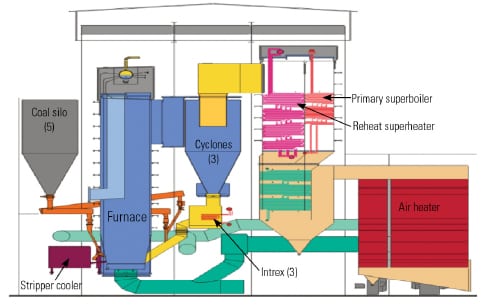 |
| 1. Chasing agglomerated ash. The circulating fluidized bed boiler produces steam in the furnace section but superheats the steam in the Intrex units and in other superheater tubes, as shown. The ash-fuel-limestone mix circulates vertically from the furnace, through the cyclones and Intrex units, and then back to the furnace via the loop seal. Ash agglomeration and mechanical design problems with the Intrex were a chronic problem since plant startup in 2002. Source: JEA |
However, a 70% petcoke mix required two to four outages a year to remove ash buildup and agglomeration. The plant also faced other challenges, such as limestone feed problems and stripper cooler plugging, cyclone furnace problems, and myriad Intrex superheater tube failures, to name the worst offenders. During calendar years 2003 and 2004, the plant averaged 6,146 hours of operation with a 62.3% capacity factor and an equivalent availability factor of 65.8%—well below industry averages. Ash agglomeration and performance of the Intrex units had become chronic problems.
Each boiler has three enclosures, and each box contains both a loop seal and superheater coil with the loop seals submerged in a bath of semi-molten 1,700F ash (Figure 1). Intrex operational problems included superheater tube support failures and cracking of superheater tubes, plus agglomeration of hot loop material within the boxes whenever less than 30% coal was burned. By the close of the two-year demonstration period, the same two problems remained unresolved: agglomeration of ash on heat transfer surfaces in the boiler and Intrex units and poor mechanical performance of the Intrex units. Together, these two problems accounted for a majority of the 13.3% equivalent forced outage rate (EFOR) average for both CFBs from 2003 to 2008.
In the words used in the final report (June 2005—three years after startup), “long term modifications to mitigate these issues on Northside CFB boilers are ongoing.” One lesson learned by Foster Wheeler during the two-year demonstration period was that “the Intrex design is not viable, and [Foster Wheeler] is no longer offering this design feature on new CFB boilers.”
Ending Ash Agglomeration
JEA chose to forgo a plant modification to eliminate the Intrex superheater that cost an estimated $40 million per unit and required extensive outage time. Instead, it attacked the problems through data analysis and continuous improvement of the existing systems.
Solving the ash agglomeration problem required a long-term design and test project to produce permanent and reliable solutions. Rather than discuss those details in the limited space available in this article, a companion report, “Reducing Ash Agglomeration in JEA’s CFB Boilers,” is included in this issue (p. 52). That article focuses on the process used to identify the particular agglomeration mechanisms at work and the permanent solution that was implemented at NGS. In brief, the injection of a specific reagent at a rate of 1.8% of the fuel flow (by weight) has virtually eliminated ash agglomeration in the CFB boilers. That permanent solution was implemented in June 2008.
Intrex Superheater Fix
Despite the many CFB improvements and modifications made between 2006 and 2008, the Intrex remained extremely problematic, causing frequent shutdowns and power output limitations. Generally, there were two interrelated phenomena:
- Ash buildup (agglomeration) in the Intrex caused loss of fluidization; plugging of the cyclones quickly followed by loss of steam temperature control. The solids buildup was first observed during furnace startup in 2002.
- Frequent tube leaks in the Intrex superheater tubes were due to stress-corrosion cracking. The root cause was ash buildup on the tubes that resisted tube thermal expansion, occasional overheating, and the ash-filled corrosive environment within each Intrex.
Between 2007 and 2009, Intrex performance continued to improve through data analysis and process optimization. Final modifications were made to the Intrex in the fall of 2009 during a tube replacement outage. NGS staff performed a complete in-house redesign of the Intrex. The designers realized well-controlled airflow was essential to ensure good circulation within the Intrex units to prevent agglomeration of solids on the tubes and for improved combustion in the CFB. With those changes in mind, the following modifications were made to each Intrex:
- Tube supports that improved fluidization and eliminated ash buildup from restricting tube thermal expansion were added and/or moved.
- The weir walls (adjacent to the superheater tubes) were replaced with an ash-retaining wall to aid furnace circulation.
- Return cells that eject ash from each Intrex were redesigned.
- Intrex fluidization air supply and valves were replaced.
Top Tier Statistics
The NGS CFBs, which currently burn up to 90% petcoke, had an average 0.7% EFOR for fiscal year (FY) 2011 (starting Oct. 1, 2010) and have averaged 0.25% EFOR thus far in FY2012. These operating statistics place NGS in the top tier of U.S. fossil plants.
In addition, the CFBs have seen a significant improvement in long-term heat rate with these improvements, and forced outage costs have nearly disappeared. JEA also has been able to avoid over $90 million in capital projects such as further boiler redesigns, Intrex replacements, and stripper cooler replacement.
Finally, during the 2009 fall outage, the original 1966-vintage steam turbine low-pressure rotor was replaced in each unit. Together with other modifications, the output of each unit was boosted by about 15 MW, further improving each unit’s heat rate and producing significantly higher power sale revenue.
— Dr. Robert Peltier, PE is POWER’s editor-in-chief.







